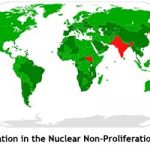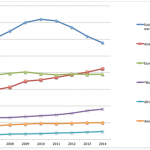The Treaty on the Non-Proliferation of Nuclear Weapons (also known as the Nuclear Non-Proliferation Treaty, or NPT) is an international agreement designed to prevent the spread of nuclear weapons, promote cooperation between states on peaceful uses of nuclear energy, and advance nuclear disarmament. The NPT was opened for signature on July 1, 1968, and the […]
Fact Sheet: Global Nuclear Weapons Inventories in 2017
Unless otherwise specified, all information in this chart comes from Kristensen’s and Norris’s Status of World Nuclear Forces 2017 CHART: Global Nuclear Weapons Inventories 2017 Deployed Non-deployed Retired Total United States[i] ~1,740a ~2,260 ~2,800 ~6,800 Russia[ii] ~1,950a ~2,350 ~2,700 ~7,000 France ~280 ~10 * ~290 United Kingdom ~120 ~95 * ~215 China 0 […]
1 Year Later, U.K.’s Nuclear Deterrent Base Remains in Scotland and Awaits Modernization
Last Friday marked the one-year anniversary of the Scottish independence referendum in 2014. The United Kingdom’s nuclear deterrent, four nuclear-armed Trident submarines based at Faslane, Scotland, was a hot topic a year ago. The Scottish National Party vowed to scrap the subs if Scotland broke away. But after 55.3% of voters decided to stay with […]
U.S. Defense Spending Vs. Global Defense Spending
According to the SIPRI Military Expenditure Database 2015, in 2014, the U.S. approved $609.9 billion in defense budget authority (fiscal year 2014 dollars). This figure includes funding for the Pentagon base budget, money allocated for the Pentagon in the Overseas Contingency Operations fund, and defense related activities in the 050 budget function. It also includes Department of Energy-administered atomic energy defense activities.
Humanitarian Conference: Nukes and Humanity are Incompatible
The Third International Conference on the Humanitarian Impacts of Nuclear Weapons took place in Vienna last week, and generated momentum towards the Non-Proliferation Treaty’s ultimate goal of nuclear disarmament. The two day conference concluded with an expected “Chair’s Summary,” reflecting the main findings of the conference: nuclear weapons and humanity are incompatible, and an unexpected “Austria Pledge”, in which Austria acknowledged the inherent risk nuclear weapons pose to humanity and vowed to “fill the legal gap for the prohibition and elimination of nuclear weapons” and “cooperate with all stakeholders to achieve this goal.” In addition, Austria called on all members of the Non-Proliferation Treaty (NPT) to renew their commitment to meeting the disarmament pledge and take concrete steps towards reducing the risk of nuclear detonations.
The conference was attended by 158 countries, including four nuclear-armed states (United Kingdom, United States, India and Pakistan), alongside delegates from the United Nations, the Red Cross, and a wide array of civil society organizations dedicated to reducing the global threat posed by nuclear weapons. This was a continued improvement from humanitarian conferences of the past; the United States and United Kingdom both sent official delegations for the first time and even China sent an observing party.
While lacking in tangible policy agreements, the conference demonstrated a growing consensus around the danger that nuclear weapons pose on humanity. Survivors of nuclear attacks and tests, the Pope, diplomatic leaders, alongside various academics and celebrities all spoke out against the dangerous reliance on nuclear weapons for deterrence and stability. The crowd was particularly captivated by the remarks of Setsuko Thurlow, a survivor of the Hiroshima explosion, whose testimony highlighted the indiscriminate and widespread nature of an atomic detonation. This testimony supported the presentations by scientists and members of civil society, who agreed a nuclear detonation would have catastrophic, long-lasting effects on human existence while providing little opportunity for humanitarian organizations to mitigate the suffer.
The Center for Arms Control and Non-Proliferation and its sister organization, Council for a Livable World, signed a letter with its partners urging the United States to attend the conference. Angela Canterbury, executive director of both organizations, emphasized the importance of including the humanitarian perspective in nuclear weapons discussions: “The nuclear weapons employed today are magnitudes more powerful than their World War II predecessors and their devastating effects cannot be contained by state boundaries, presenting risks on the regional and global scale. It is the United States’ responsibility to champion smart policy that deemphasizes the role of these catastrophic weapons in national security.”
Many non-nuclear weapons states, who are frustrated with the stagnation of reduction efforts by nuclear-armed states, hope to use this conference’s momentum to renew calls for nuclear reductions and disarmament. Kingston Reif, Director for Disarmament and Threat Reduction Policy at the Arms Control Association, was an attendee of the Vienna Conference. Reif commented that the conference was not just a “flash in the pan”: ““The frustration among many non-nuclear weapons states with the pace of progress on nuclear disarmament is palpable. The humanitarian consequences discussion has brought in voices and representatives that haven’t typically been part of the Non-Proliferation Treaty (NPT) review process and figures to be a major issue at the 2015 NPT Review Conference.” With the NPT Review Conference approaching in the spring 2015, we are likely to see a resurgence of calls to ban nuclear weapons, especially if the proposed efforts outlined by the Austria Pledge yield legal frameworks for pursuing those ambitions.
Only time will tell if the International Campaign to Abolish Nuclear Weapons will maintain its momentum gained during the Vienna Conference. Though with 44 states, the Pope, and scientists and celebrities from around the globe calling for a prohibition on nuclear weapons, their voices are growing stronger.
Greg Terryn is a Scoville Fellow at the Center for Arms Control and Non-Proliferation



